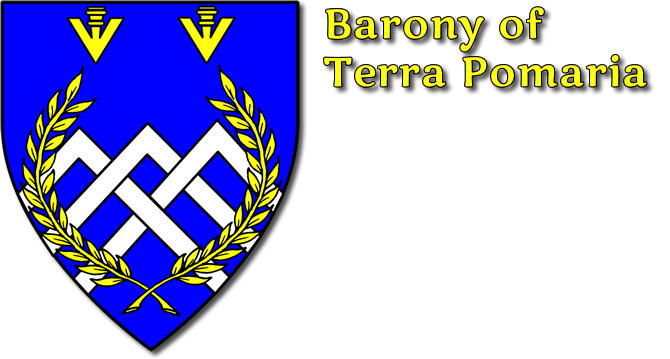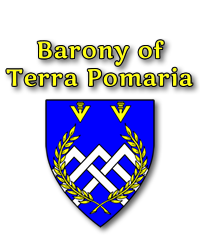19 Jul How to eat bacon
Then Serve It Forth…
By Lady Rosemary Willowwood de Ste. Anne
I seem to be lapsing into the “several things” habit – this month it’s a recipe, a history tour, and a recommendation for a very informative book on historical cooking and health. The book is called Anthimus – On the Observance of Foods, translated and edited by Mark Grant [1] . Mr. Grant offers both an Latin/English dual language translation format, and a superb exposition of the author’s place in the surrounding history, as well as a very affordable price-tag. I have supplied the ISBN number in footnotes, and recommend the book, the author, and the publisher very highly.
“How to eat Bacon”
From De obseruatione ciborum ad Theudericum regam Francorum epistula
Anthimus, +/- 530 c.e., translated and edited by Mark Grant
De larido uero, unde non est qualiter exire delicias Francorum, tamen qualiter melius comedatur ad horam expono. si assatum fuerit ad horam quomodo bradones, pinguamen ipsum defluit in foco et laridum deuenit siccum, et qui manducauerit, laeditur, nam non iuuatur; etiam et malos humores generat et indigentionem facit. sed elixatum laridum et refrigeratum si manducatur, melius iuuat et ventrem constrictum temperat, et bene digeritur. sed bene debet elixari; certe si de perna, pus debet coqui. de cute uero ipsa nihil praesumatur, quia non conficitur. frixum uero laridum penitus non praesumendum, quia satis nocet. pinguamen ipsius laridi, quod in cibo aliquo supermissum fuerit uel supra olera, ubi oleum, non fuerit, non nocet. nam illa frictura penitus non expedit.
TRANSLATION: Translation is by Mark Grant, as noted in the footnote. In the book, this translation is presented as “dual language”, Latin on the left page and English on the right.
At this point I will explain how bacon may be eaten to the best effect, for there is no way that I can pass over this Frankish delicacy. If it has been simply roasted in the same way as a joint of meat, the fat drains into the fire and the bacon becomes dry, and whoever eats it is harmed and is not benefited; it also produces bad humors and causes indigestion. But if bacon that has been boiled and cooled is eaten, it is more beneficial, regulating constipated bowels and being well digested. But it should be boiled well; and if of course it is from a ham, it should be cooked more. None of the rind should be eaten, because it is not digested. Bacon fat which is poured over some foods and vegetables when oil is not available is not harmful. But frying brings absolutely no benefit.
REALIZATION: Please suspend your disbelief for a few minutes, before you write off the idea of “boiled bacon” entirely. This dish was common in Roman times, and through into the middle ages. But first you must lose your preconception that bacon is something fried crisp served with eggs for breakfast.
For this dish, choose uncut slab bacon, with at least equal amounts of lean and fat. It is even better if you can find a piece which tends even farther toward lean. If the piece still has skin on it, carefully peel it off with a sharp knife. Slice the bacon in lengthwise rashers (see glossary) about two or three times the thickness of thick-sliced commercial bacon, or about a generous 1/4 inch thick. Place the bacon in a skillet in a single layer or slightly overlapping, add enough water to barely cover, and simmer uncovered over low heat for about 30 minutes. Drain any remaining liquid, and chill until cold. For Anthimus’ recipe, the dish is completed. It may be eaten cold, like ham.
The bacon may also be simmered in a whole slab, in water to halfway cover, for about an hour. The slab should be turned once during the simmering. It should be drained, chilled, then sliced to the desired thickness.
This recipe is a bit more accessible when one understands what Anthimus’ purpose was in writing the letter to the king. Anthimus was not a cook, but a physician, whose primary care was seeing that the King’s subjects were as healthy (and therefore as useful to the king) as they could be. The primary medicine which doctors could prescribe in those days was not drugs, but a visit from “Doctor Diet”. (I may also introduce his colleagues, “Doctor Quiet” and “Doctor Merry-Man”, in another column.) Diet was a critical part of balancing the humors, and a housewife’s role as cook also extended to easing the sick and keeping her household healthy by giving them the healthiest food possible, according to the research scientists of her day.
Anthimus’s interest was not in making the food tasty. But a Roman cook, styled “Apicius”, writing in Latin of about the same era as Anthimus (i.e., 5th-6th c. Rome), noted essentially the same recipe, with an added Roman touch. “Preparation of bacon. Cover with water and cook with a lot of dill. Sprinkle with a few drops of oil and a little salt.” [2] You can follow Apicius’ lead and spice up the bacon without contradicting Anthimus’ recommendation at all. In fact, once the bacon is boiled and chilled, it may be GENTLY warmed, but not browned, in a pan, cut into smaller slices, and used as one would use ham. In fact, thin slices of ham were prepared in exactly the same way.
The history involved here is the fame accorded to the Frankish and Gaulish Celts for preparation of pork products even as far back as Roman times and before. The Celtish Hallstatt culture was known for both its salt production and its use of pork. In fact, in about the 1st century b.c.e., the well-traveled historian Strabo noted that the most prized hams in Rome came from the forests of Burgundy. [3] In fact, this seemingly plain dish can take on a lot of variation, if you search for slabs of specialty bacon with different techniques of cure, and different woods used to smoke the meat.
GLOSSARY:
Rasher: A slice, or serving of slices, of bacon or ham, usually broiled or fried.
[1] Grant, Mark, trans. & ed., Anthimus – De obseruatione ciborum; Prospect Books, Totnes, Devon, 1996. ISBN 0907325 750
[2] Edwards. John, The Roman Cookery of Apicius, Hartley & Marks, Washington, 1984, p. 167.
[3] Kurlansky, Mark, Salt – A World History, Walker Publishing Co., New York, 2002, p. 65.



